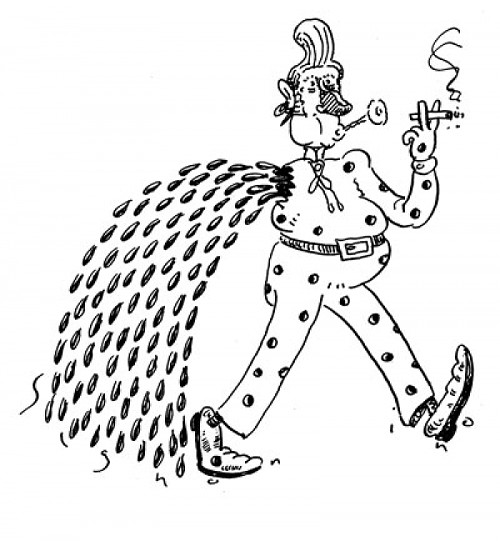In many movies and books where the protagonist needs to be injured for dramatic effect but not killed, he’s shot in the shoulder (usually about 3 or 4 inches down from the top surface of the shoulder and a few inches in from the armpit). The result is usually painful and bloody, but the character often has no trouble later using the affected limb—“later” meaning a few minutes at most. My question is this: How dangerous are puncture wounds of this type? What harm can they do (collapsed lungs, severed arteries, etc.), and how realistic are such portrayals in film? —Trevor R., Allentown, Pa.
Depends on what larger issue you’re getting at here. Is it plausible, in a fictional context, to have the protagonist take a bullet and pull through? Sure—four of five gunshot wounds are nonfatal. Is there such thing as a safe place to get shot? Don’t be absurd. There’s a one in five chance you’ll be killed.
Surviving a gunshot wound is often described as a matter of luck, but that’s not to say it’s random. Take the case of Kenny Vaughn of North Carolina. In 1995, an ex-neighbor, apparently seriously pissed off, shot him roughly 20 times at point-blank range in the chest, groin, abdomen and extremities. Miraculously, Vaughn survived.
Was he lucky? Absolutely, but he had several kinds of luck. Unquestionably, his biggest break was that his assailant didn’t shoot him in the head—a bullet between the ears is three times as likely to kill you as one anywhere else.
Vaughn’s second-biggest break was that the shooter used a .22-caliber rifle, a relatively low-powered weapon. Had the assailant used, say, a Bushmaster assault rifle, the outcome would likely have been different. An ordinary .22 rifle slug carries, at most, a couple hundred foot-pounds of energy. The Bushmaster’s .223 slug is only slightly larger in diameter, but its much greater mass and muzzle velocity gives it 1,300 foot-pounds of energy, enough to shatter bone and shred flesh.
It’s only when we get to Vaughn’s third break that we can credit sheer dumb luck. He was, after all, hit several times in the chest, and 85 percent of fatal gunshots involve wounds to the head or trunk. In his case, however, none of the bullets pierced a vital organ or major blood vessel. Two missed his heart by less than an inch.
The lesson here is that, allowing for an element of randomness, a fictional hero can plausibly survive a gunshot wound to the shoulder if the weapon is at the low end of the lethality scale—for example, a small- to medium-bore handgun. I emphasize, however, that less deadly doesn’t mean harmless—handguns are lethal enough to have accounted for nearly half of U.S. murders in 2011.
Writers no doubt target the shoulder for nonlethal bullet wounds on the assumption that it contains no vital organs. In reality, however, it can be a dangerous place to get shot. The shoulder contains the subclavian artery, which feeds the brachial artery (the main artery of the arm), as well as the brachial plexus, the large nerve bundle that controls arm function.
If you get hit in the brachial plexus, you’re probably not going to be walking around good as new five minutes later. A study of 58 gunshot victims wounded in the brachial plexus found 51 of them needed follow-up surgery to deal with blood-vessel damage, severe pain and loss of motor function. As for the subclavian artery, a study from a New Orleans hospital reported that out of 16 cases of acute injury thereto, four patients died and another lost the arm.
Still, all this tells us is that a gunshot to the shoulder is potentially pretty bad. What happens in the real world? I had my assistant Una review 79 news reports of persons shot in the shoulder in 2012. Among the more memorable episodes:
A 9-year-old Pennsylvania girl wearing a black & white Halloween costume was shot in the shoulder by a shotgun-wielding relative who mistook her for a skunk.
A California weightlifter claimed he’d gotten his shoulder wound when he dropped a dumbbell on a .22-caliber cartridge, causing it to fire.
Following an argument over the price of condoms, a Detroit convenience-store clerk pulled out a gun and fired a warning shot into the shoulder of an unruly customer, who subsequently died.
But that last guy was the exception. Only three of the 79 shoulder wounds Una looked at resulted in the victim’s death. Writers therefore may indulge in this shopworn gambit without fretting that they’re taking factual liberties. I still wouldn’t volunteer.
Send questions to Cecil via StraightDope.com or write him c/o Chicago Reader, 350 N. Orleans, Chicago 60654. Subscribe to the Straight Dope podcast at the iTunes.
More by Cecil Adams
-
This Is the End, My Friend
This week's Straight Dope marks the last appearance of the column as the Teeming Millions have known it for the past 45 years.
- Jul 11, 2018
-
Do Brain Supplements Do Anything?
Brain Drain
- Jul 4, 2018
-
Is flying really worse for the environment than driving?
Planes and Trains
- Jun 27, 2018
- More »




